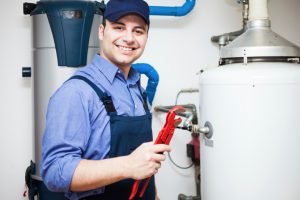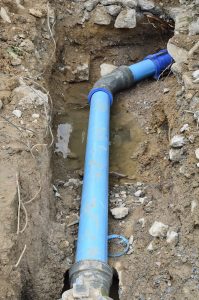 Plumbing systems are notoriously difficult to keep in good shape over the years. They have a multitude of different ways to develop problems, and when they do they tend to happen without you immediately noticing. You can take certain steps to make sure that your plumbing system stays in good condition, of course. You just need to make sure that you do it consistently. Follow our tips below to make sure that your plumbing system stays in good shape for as long as possible.
Plumbing systems are notoriously difficult to keep in good shape over the years. They have a multitude of different ways to develop problems, and when they do they tend to happen without you immediately noticing. You can take certain steps to make sure that your plumbing system stays in good condition, of course. You just need to make sure that you do it consistently. Follow our tips below to make sure that your plumbing system stays in good shape for as long as possible.
Saddleback Plumbing Heating & Air Blog: Posts Tagged ‘Plumbing Maintenance’
How to Keep Your Plumbing in Top Condition
Monday, September 24th, 2018Why You Should be Scheduling Preventive Plumbing Maintenance
Monday, August 27th, 2018 Plumbing problems are not the sort of thing that you should just wait around to address. Most people won’t ignore a leak once it starts flooding their home, though. When we talk about waiting around, what we mean is that it’s not a good idea to wait for signs of a problem before you have it dealt with. The best way to have issues taken care of before they progress far enough to cause problems is to schedule preventive plumbing maintenance.
Plumbing problems are not the sort of thing that you should just wait around to address. Most people won’t ignore a leak once it starts flooding their home, though. When we talk about waiting around, what we mean is that it’s not a good idea to wait for signs of a problem before you have it dealt with. The best way to have issues taken care of before they progress far enough to cause problems is to schedule preventive plumbing maintenance.
Follow These Tips to Keep Your Plumbing System Healthy
Monday, May 7th, 2018 It can be difficult to keep a plumbing system in top condition for a long period of time. Most of the system is out of sight, and therefore out of mind. People tend not to think about their plumbing at all until it stops working for whatever reason. Still, we recommend making sure that your plumbing system stays healthy as best you can. You’ll save more money on repairs in the long run, and you won’t have to worry so much about things like water damage or not being able to take a shower. Follow the tips below to make sure that your plumbing system keeps serving you well for many years to come.
It can be difficult to keep a plumbing system in top condition for a long period of time. Most of the system is out of sight, and therefore out of mind. People tend not to think about their plumbing at all until it stops working for whatever reason. Still, we recommend making sure that your plumbing system stays healthy as best you can. You’ll save more money on repairs in the long run, and you won’t have to worry so much about things like water damage or not being able to take a shower. Follow the tips below to make sure that your plumbing system keeps serving you well for many years to come.
Tips on Keeping Your Plumbing System in Good Condition
Monday, June 5th, 2017 It can be tough trying to keep your plumbing system in good condition, for a number of reasons. Plumbing systems are pretty sturdy, but they’re also mostly hidden from view. When a problem crops up in a plumbing system, most homeowners won’t notice it until it’s caused widespread damage. Because plumbing systems rarely demand a lot of attention, most homeowners don’t remember to schedule preventive maintenance for them. This leads to a lot more issues, and shortens the effective lifespan of many plumbing appliances. If you want to keep your plumbing system in good shape for as long as possible, follow our tips below.
It can be tough trying to keep your plumbing system in good condition, for a number of reasons. Plumbing systems are pretty sturdy, but they’re also mostly hidden from view. When a problem crops up in a plumbing system, most homeowners won’t notice it until it’s caused widespread damage. Because plumbing systems rarely demand a lot of attention, most homeowners don’t remember to schedule preventive maintenance for them. This leads to a lot more issues, and shortens the effective lifespan of many plumbing appliances. If you want to keep your plumbing system in good shape for as long as possible, follow our tips below.
Prepare Your Water Line for the Next Earthquake with These Steps!
Monday, April 24th, 2017 It’s been a while since we’ve had an earthquake of truly catastrophic proportions, though rest assured that’ll happen at some point. It doesn’t take a shaker strong enough to topple buildings to damage your home’s plumbing system, though. Even if the rest of your home is in fairly good condition after a moderate earthquake, it could suffer not-insignificant damage to its plumbing system.
It’s been a while since we’ve had an earthquake of truly catastrophic proportions, though rest assured that’ll happen at some point. It doesn’t take a shaker strong enough to topple buildings to damage your home’s plumbing system, though. Even if the rest of your home is in fairly good condition after a moderate earthquake, it could suffer not-insignificant damage to its plumbing system.
Plumbing Tip 13: Sump Pump Maintenance
Monday, April 15th, 2013Your sump pump is designed to prevent water flooding in your basement, and the ensuing damage that can result. It is installed in the lowest part of your basement, and connected to a drainage system that removes the water from the premises. Depending on whether you have an upright or submersible unit, the maintenance tasks will vary. But as with any system, routine maintenance is the best way to keep it in tiptop shape. Because your sump pump may only operate occasionally, when there is flooding or a large storm, maintenance is all the more important. Don’t take any risks with your water insurance device. For Tustin CA plumbing, call the experts at Saddleback Plumbing today!
Here are some typical sump pump maintenance duties.
- Check the electrical power supply. Make sure that your unit is plugged in, and that if you have a battery backup system, the batteries are in working condition. In the event of a flood or serious storm, your power may also go out, and if you don’t have a backup generator, then your sump pump cannot work. Battery backup is a great feature.
- Thoroughly inspect all aspects of the pump. Your technician will inspect all aspects of the sump pump in order to ensure that any parts are properly lubricated and free of debris.
- Clean pump inlet screen. The pump inlet screen filters the water that the sump pump absorbs so that the mechanical components do not get clogged with debris, typically small rocks, or clumps of dirt.
- Test it out. Throw a pail of water into your sump pump pit in order to see if it’s working properly. Because your sump does not run constantly like other appliances in the home, this will give it a bit of practice, and you can monitor it to judge the performance.
- Clean out the pit. Make sure that the pit itself is clean and clear, so that in the event of a flood, your sump pump will be ready to perform.
For more information about improving your sump pump, or to schedule a Tustin, CA plumbing service, contact Saddleback Plumbing today!
Plumbing Tip : What Does Plumbing Maintenance Involve
Tuesday, January 29th, 2013Is it time for routine maintenance for your plumbing system? Call the Irvine plumbers at Saddleback Plumbing! We can handle all your plumbing maintenance needs, including providing tips and advice on how to get the most out of your system. Remember that routine maintenance can prevent repair issues, slow drains, clogs, and other problems. Call us any time for your next service!
Here are some tasks we can do during routine maintenance.
Video Pipe Inspection
When we provide a maintenance service or respond to a repair need, our plumbers send a video camera down your plumbing system to inspect the inside of the pipes. This allows our plumbers to get a close-up look at any kind of plumbing problems that might be further down the pipe or drain line. We’ll be able to see exactly where the problem is and what specifically is causing it. For instance, if there’s a tree root causing a leak in a sewer line, we can see that and know the best solution for this issue.
Gas Piping Maintenance
When you call us for a repair or maintenance service, we also inspect your gas piping. Our plumbers are trained and certified to work with gas lines and earthquake emergency shut off valves. We test these safety devices to ensure that they will work when you need them.
Professional Drain Cleaning
With a professional drain cleaning, our Irvine plumbers will thoroughly clean your plumbing system safely and effectively. Hydro-jetting uses a powerful stream of water to clear out any clogs or blockages that are in your plumbing system. While only one way to clean your system, hydro-jetting will not damage your plumbing system. Drain cleaners use harsh chemicals, so avoid using conventional drain cleaners.
Call Saddleback any time for your next plumbing maintenance service!
Value of a Plumbing Maintenance Agreement in Balboa
Wednesday, September 14th, 2011Consider for a moment the cost of fixing a leaky pipe or a burst water main in your Balboa home. Imagine how much money goes down the drain (so to speak) if you don’t have someone on call to come and fix the problem whenever you notice a drippy faucet or see a wet patch on your ceiling. This stuff will add up fast.
That’s why so many plumbers offer extended maintenance agreements to keep your fixtures and pipes on track. In most cases, these maintenance agreements are assigned to specific pieces of equipment such as your water heater, your toilet, your sinks and showers, or your pipes. However, there are many plumbers who offer full coverage of your home for a set annual fee. Let’s take a closer look at what that would do for you.
Full Annual Coverage
If you pay for a full annual maintenance plan for your home, it would cover yearly checkups of the following:
- Water heaters
- Radiant heating system
- Incoming water mains
- Pipe conditions
- Fixture and drain health
- Sewer and drain lines
Now, imagine how many years go between checkups of these things normally. When was the last time you had someone visit your home and check your drains for clogs or inspect your water main for stress and wear? Have you ever had it inspected?
Most homeowners forget about their plumbing for years until it needs a repair or replacement. Replacing a toilet costs $400 or more. Replacing a water line in your house costs upwards of $3500. And if you need pipes replaced, it can cost anywhere from $2,000 to $5,000 depending on the size of your home.
The Annual Savings
For a small investment, you prolong the life of your plumbing by years and the cost of replacement will be negated by having small repairs completed on an annual basis. Simply having a leak patched or a clog cleared costs $100-$300 versus the thousands of dollars it will cost to replace something – all fantastic reasons to consider an annual maintenance plan.
How Can I Fix a Leaky Faucet? A Question From Irvine
Monday, September 12th, 2011Leaky faucets certainly are not the type of emergency you want to call an Irvine plumber for, but they are also pretty inconvenient and annoying. Fortunately, they are often quite easy to fix. The proper procedure for fixing a leak in your faucet will depend on the type of faucet you have, but it is always a relatively simple task.
If you know what type of faucet you have, you are ahead of the game. But if you do not, you will need to take your faucet apart first to see what is going on in there. Especially in older homes, the most common type of faucet is a compression faucet. This means that inside the faucet there is a rubber washer that helps to create the seal when the faucet is tightened.
When faucets like this leak, chances are it is simply because the washer has worn out and needs to be replaced. Before you can start working, you will first need to turn off the flow of water to your sink. There should be a couple of knobs under the sink that allow you to do this. And be sure to cover or plug the drain before you begin so that you do not accidentally drop anything down it as you are working.
Once you have set yourself up, unscrew the faucet handles (or whichever one is leaking) and remove the outer part. At this point, you should be able to see the washer. Simply remove it and replace it with a new one and then put the faucet handle back on and you should be as good as new. These types of washers tend to wear out from time to time, so you will probably have to do this again in a few years or so.
When you are replacing your washers, though, it is important to remember a couple of things. First, if you are unsure about what type of washer to put in your faucet, take the old one to the store with you and ask a salesperson for help. You want to make sure that the washer you put in is exactly the right fit for your fixture so it is worth taking the extra step to ensure that you have the right piece.
And after you have taken apart the faucet, it is a good idea to check the stem to see if that has worn out and needs to be replaced as well.
How Much Water Does a Leaky Faucet Waste?
Friday, August 5th, 2011A leaky faucet is obnoxious for more than one reason, as I discovered the other night at my house in Fullerton. It is incessant, it represents a problem that will probably only grow worse, and it can cost you money on your water bill. Beyond all of that, it wastes a lot of water, putting undue stress on the environment. But, how much water does a leaky faucet actually waste? It may not seem like much, but when added up over a period of time, that leaky faucet’s impact can be fairly substantial.
Okay, so a single drip every couple seconds may not seem like a lot of water. But, think about it this way. If you let your faucet drip every day, twenty four hours a day, it is definitely going to add up. Imagine what would happen if every faucet in your home was dripping or every faucet in your neighbourhood. It would not seem like such a small amount of water anymore.
In terms of how much water is actually wasted, it is impossible to tell for certain. After all, every drop of water from a faucet is a different size and falls at a different rate. But, for the most part the water coming from a faucet (according to the US Geological Survey) is between 1/5 and 1/3 of one milliliter. Using those calculations and 1/4 of a milliliter as an average, the USGS estimates that roughly 15,140 drips from a faucet equals one gallon of water.
It may not seem like much. After all, fifteen thousand drops is a LOT of drops. But, if your faucet dripped once every second every day, all day, it would only take four and a half hours to reach one gallon. Every day you would waste 5 gallons of water or 2,082 gallons per year. That is 10% of the average water used by a standard 3.5 gpf toilet on a daily basis. Now, imagine what happens if you have more than one drippy faucet, or if your bathtub leaks which will drip more water at a time or if the leak is larger than the average size.
In short, the cost of a leaky faucet may not seem like much, but as time passes, it can really add up and if it is not taken care of, the cost will only grow as the leak gets bigger and potentially new leaks start in other faucets of your home. Do not let it drip forever – take action now and cut down on the environmental impact you have, as well as your bill.
